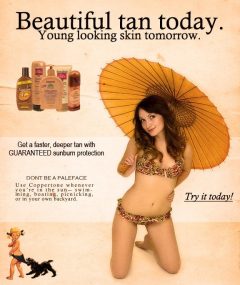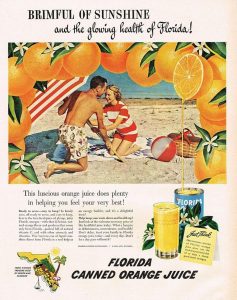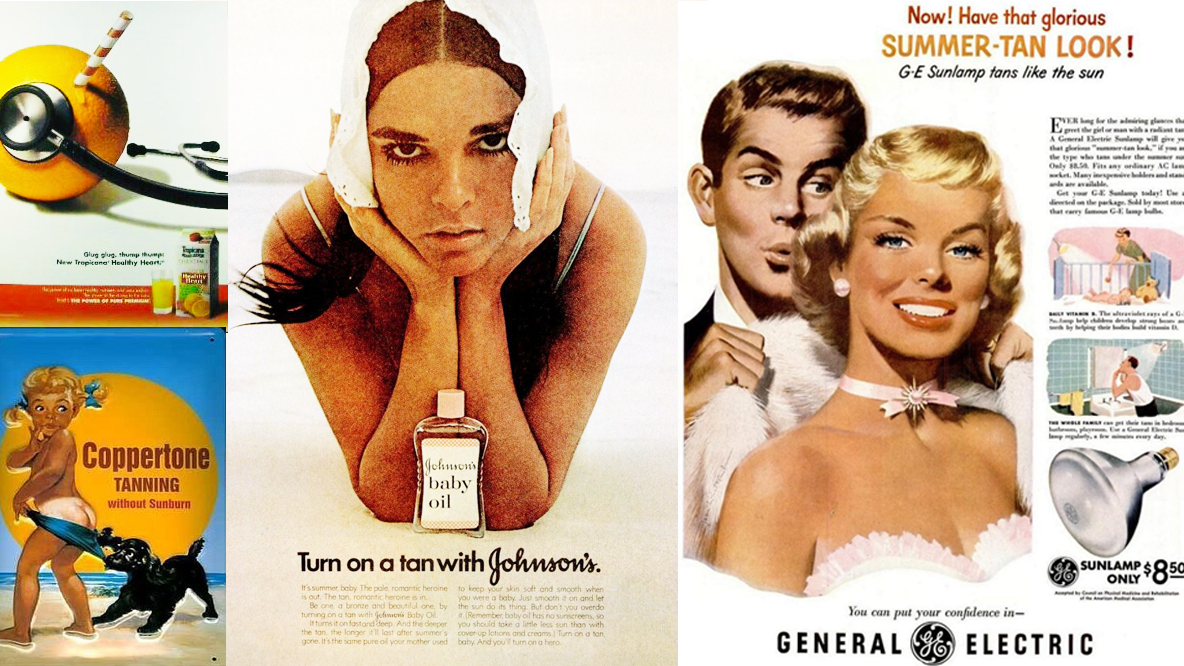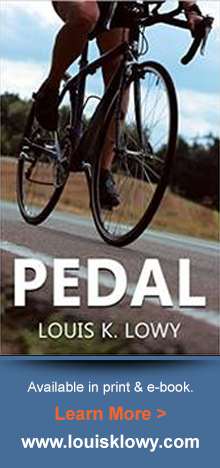The Big Falsehood!
When I grew up in south Florida every other TV commercial, radio commercial and billboard advertised “To be healthy and popular use Coppertone for a deep rich tan.” Another huge falsehood was, “To be healthy drink Florida orange juice” plus Johnson & Johnson Baby Oil and GE Sunlamps.
My Dermatologist always says, “Sun damage is accumulative” All the sun I was exposed to growing up in Florida I am still paying the price. Remember: It’s important to keep your skin healthy now. Your future self will thank you for it.
Suntans were the big beauty buzzword, starting in the ’50s.


- Coppertone ad headline uses the words Beautiful and Young Looking.
- Orange Juice with Sunshine and Glowing Health.
Citrus Juice:
Researchers at Brown and Harvard have discovered that eating citrus may raise a person’s risk of developing melanoma. Their study — a huge one that includes over 100,000 Americans over 26 years, published in the Journal of Clinical Oncology — found that people who had a serving and a half of citrus each day were 36 percent more likely to get melanoma than people who consumed just two servings per week. (A serving was defined as an orange, half a grapefruit, or six ounces of juice.)
This could be because citrus contains lots of furocoumarins, a group of photo-active substances that become more toxic when they’re exposed to the sun’s UV rays. They warn people who drink orange juice every morning, or have some sort of serious daily grapefruit regimen, to “avoid prolonged sun exposure.”
Baby Oil:
Sunscreen is used to protect the skin against the sun’s ultraviolet (UV) rays. When the skin burns, this increases a person’s chance of the skin aging, wrinkles and getting skin cancer.
Baby oil is a liquid intended to be used with infants to help with preventing bacterial growth on their skin.
Studies have also shown that baby oil can heighten your risk of skin cancer, such as melanoma. Due to this when tanning don’t with baby oil and always make sure to wear sunscreen and other skin protection tools.
All people should use sunscreen when they are outside. It’s recommended you use sunscreen with an SPF of at least 30 to protect the skin.
There is no such thing as a safe tan. The increase in skin pigment, called melanin, which causes the tan color change in your skin is a sign of damage. Why it happens: Once skin is exposed to UV radiation, it increases the production of melanin in an attempt to protect the skin from further damage.
Consequences:
Evidence suggests that tanning greatly increases your risk of developing skin cancer. And, contrary to popular belief, getting a tan will not protect your skin from sunburn or other skin damage. The extra melanin in tanned skin provides a Sun Protection Factor (SPF) of about 2 to 4; far below the minimum recommended SPF of 30.
Premature Aging
What it is:
Sometimes referred to as “photoaging,” premature aging is the result of unprotected UV exposure. It takes the form of:
- Leathery
- Wrinkled Skin
- and Dark Spots
Why it happens:
Although the causes of premature aging are not always clear, unprotected exposure to harmful UV rays break down the collagen and elastin fibers in healthy young skin, and cause wrinkles and loosened folds. Frequent sunburns or hours spent tanning can result in a permanent darkening of the skin, dark spots, and a leathery texture.
Symptoms:
- Wrinkles
- Dark spots
- Leathery skin
- Treatment
GE Sunlamps:
The ultraviolet rays of a GE Sunlamps help children develop strong bones and teeth by helping their bodies build vitamin D.
Treatment Plan:
A dermatologist or plastic surgeon can develop a treatment plan based on your needs. Treatments can include:
- Chemical peels
- Dermabrasion
- and skin fillers
All people should use sunscreen when they are outside. It’s recommended you use sunscreen with an SPF of at least 30 to protect the skin.


